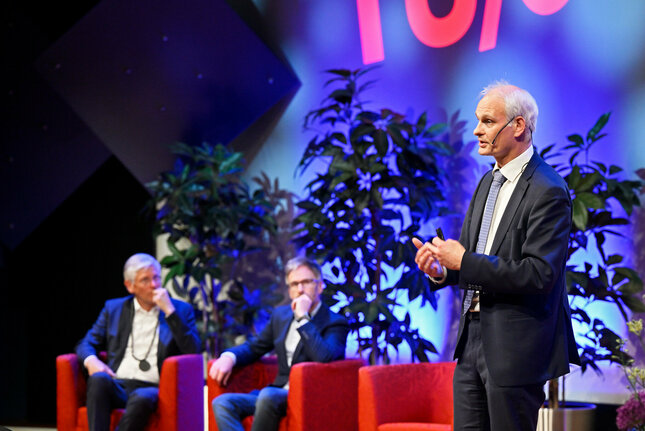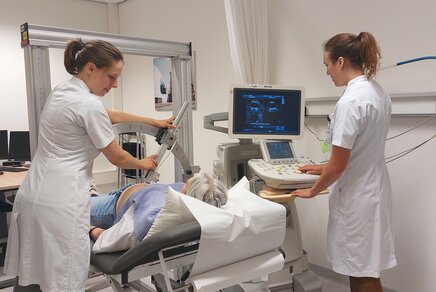TU/e professor breaks new ground with development of artificial tissue
Jan van Hest receives ERC Advanced Grant for interplay between cells ánd scientific disciplines.

Muscles are not only important for a killer body, but also for a healthy one. They are complex systems in which different cells play their own role. To better understand the function of living cells, Jan van Hest has long been developing artificial cells that can be studied outside the body. Especially there, the mutual interplay can be well observed. The next goal is to create artificial muscle tissue, because that does not yet exist. This brings better medicines, which no longer need to be tested on animals or humans, one step closer. For this project PRO-ARTIS, Van Hest is receiving an ERC Advanced Grant.
The ERC Advanced Grant is awarded annually on a personal basis and provides Jan van Hest with 2.5 million euros to spend on his own research over the next five years as he wishes. The grant means Van Hest can give his project PRO-ARTIS (Protein-regulated artificial cell populations and tissues) a flying start. Yet he is involving multiple scientific disciplines right away. "Because that's where exciting developments are taking place and that's the only way to really get ahead", he states.
"You have diggers and grazers, researchers who are totally immersed in one specific idea and researchers who want to keep discovering new things. Both are necessary for success. I myself am more of a grazer, a conceptual researcher. I like to push the boundaries of my knowledge.

You have diggers and grazers, I myself am more of a grazer. I like to push the boundaries of my knowledge.
Professor Jan van Hest
Cutting edge of disciplines
Thus, he is also attached to two TU/e departments: Chemical Engineering and Chemistry and Biomedical Engineering. His wide-ranging career brought him to the cutting edge of chemistry, biology and technology. That same cutting edge also ties in well with the ERC Advanced Grant. That award is linked specifically to an individual, but is also intended for the development of entirely new areas of research (so-called fundamental ‘high risk, high gain’ research).
"A grant like this offers significant opportunities. So obviously I am very happy about that", Van Hest says. "Not in the least because the award is peer-reviewed. Surely that does a lot."
Shrinking and swelling of muscle tissue
The new research Van Hest has in mind has two main goals: "First, I want to create artificial tissue to mimic the natural behavior of body cells in it, and then enable the growth of that artificial tissue. Take muscle tissue, for example: in a human body, collagen fibers between muscle tissue allow muscles to contract and expand again, as happens when you extend and retract your arm."
"Those collagen fibers then move over each other, allowing muscle tissue to contract and swell. Then consider that the heart is also a large muscle, in which a continuous process of contraction and expansion occurs unconsciously as you breathe. We are trying with our artificial tissue to mimic this natural behavior of shrinking and swelling. Eventually, we want to develop that more broadly than just for muscle tissue."
Live cells in a lab
Van Hest and other scientists have long been making progress in replicating living cells to study their functioning within the Institute for Complex Molecular Systems (ICMS) of which Van Hest is scientific director. "Those artificial cells contain particles with the same properties as living cells, allowing them to communicate, propel and adapt", Van Hest explains.
"That in turn affects all kinds of medical applications, such as how drugs work inside the body. If we enable those processes to take place outside the body, we can adjust them very specifically on command under controlled conditions and without physical consequences. In this way, we hope to fully test medical applications in the future in a lab, rather than on animals or humans."
New field of research
Body cells never work alone in real life, but always in close cooperation with each other. "Compare it to bacteria living in colonies", Van Hest said. "For example, they move to a food-rich source, transmit signals to each other (quorum sensing), sense each other's presence, copy themselves and thus maintain their colony. Just like cells do in muscle tissue."
"If we can mimic both the cells and that interaction, than that's a very important step for the field. And a whole new field of research in itself. By exploring cellular processes, we can better understand what goes wrong during medical applications and thus how to solve that. This allows us to develop more effective drugs, for example."
Educating new generation
Although that is not the only motivation for Van Hest, he emphasizes. "Being associated with a university also means educating new generations of researchers who are socially successful. Building expertise in this way and passing on your own knowledge and motives is perhaps the most important thing, because it goes beyond your own scientific heritage."

People from outside bring in new insights and sharpness. That's the best way to get to know a new area of interest.
Professor Jan van Hest
In that sense, the ERC Advanced Grant offers new opportunities as well. "We are now looking to expand the existing team with four PhD’s and three postdocs, which will be the next challenge, to bring in the best people. Partly we can attract our own master students, but I also want to involve people from outside with a fresh perspective. Bringing in new insights and sharpness; that's the best way to get to know a new area of interest."
The first exploratory experiments have already started and offer hopeful results, Van Hest says. "With the additional kick from PRO-ARTIS, it is expected that within two years we will have achieved the first publications in this new field."
Would you like to know more? Feel free to contact:
More on Health



